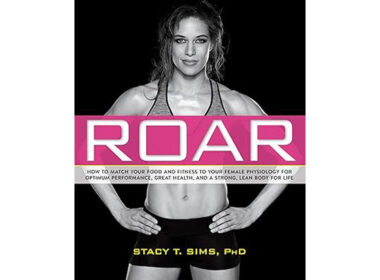Are you wondering if your exercise routine is harming your hormones? ROAR: Match Your Food and Fitness to Your Unique Female Physiology for Optimum Performance, Great Health, and a Strong Body for Life by Dr. Stacy Sims claims to offer a comprehensive, research-backed guide to training in sync with your female physiology rather than against it. If you feel like you’re slogging through workouts during certain times of the month, are overwhelmed by the idea of cycle-syncing your training, or suspect you’re underfueling for your activity level, you might wonder whether this book is for you.
If you feel like you’re slogging through workouts during certain times of the month, are overwhelmed by the idea of cycle-syncing your training, or suspect you’re underfueling for your activity level, you might wonder whether this book is for you.
Women in sports
Historically speaking, widespread female participation in sports is still relatively recent. Title IX was only passed in 1972—just over 50 years ago. Since then, women have made massive strides in athletic achievement, but most exercise-related science has continued to use male bodies as the standard. As a result, many of us have followed fitness advice or diet trends that weren’t designed with female physiology in mind. As a former collegiate athlete who had to medically retire from competitive running due to persistent injury and hormonal disruption, I was eager to learn about female-specific approaches to training. Here’s my take on whether ROAR delivers, and whether you should buy, borrow, or skip it.
Dr. Stacy Sims is a Stanford-trained exercise physiologist and nutrition scientist whose work has shaped elite training programs around the world. She has advised teams like USA Cycling and the U.S. Olympic Committee, and is known for her ability to translate complex science into actionable strategies for women at every level of fitness.
Dr. Sims is known for her simple yet powerful mantra: “Women are not small men.” Through her work, she challenges the outdated training models that overlook the menstrual cycle and female physiology. Drawing from both research and personal experience as an endurance athlete, she builds a compelling case for why women must train with—not in spite of—their hormones.
Dr. Sims is known for her simple yet powerful mantra: “Women are not small men.” Through her work, she challenges the outdated training models that overlook the menstrual cycle and female physiology.
Кто является целевой аудиторией?
The book is especially helpful for active women—whether recreational lifters, runners, or competitive athletes—who want to optimize their training, nutrition, and recovery around their cycle and life stage. Coaches and healthcare professionals working with female athletes will find Dr. Sims’s insights equally valuable.
What are the main content areas?
Part I: Your Female Physiology
In Part I, Sims unpacks the menstrual cycle and its influence on performance. She breaks down the cycle into two major phases: the low hormone phase (menstrual and follicular) and the high hormone phase (luteal). She says that during the low hormone phase, most women feel strongest, thanks to lower estrogen and progesterone. During the high hormone phase, however, increased progesterone can blunt training adaptation, increase muscle breakdown, and reduce carb storage. Sims also debunks the myth that periods always weaken performance. For many, low hormones during menstruation can actually aid strength and endurance—though individual experiences vary. If you have heavy periods, this may not be the case.
She encourages women to track their cycles as a health and performance indicator. Disrupted ovulation or delayed cycles are early warning signs that something is off—often pointing to underfueling or overtraining. She also explains how ovulation offers a brief but powerful window for peak strength and output, while warning that increased joint laxity during this time may raise injury risk.
Sims includes a discussion of hormonal birth control and its impact on training. She explains how synthetic hormones flatten natural rhythms, reduce heart rate variability, and can impair performance recovery. She offers practical tips for training on the pill while urging readers to be aware of its broader physiological effects.
Part I is rounded out with a discussion of training during pregnancy и менопауза. She encourages women to keep moving through pregnancy—adjusting intensity and volume by trimester—and offers strength routines and hydration strategies tailored for each stage. For menopausal women, she emphasizes the need for more protein and power-focused resistance training, given the loss of estrogen’s protective effects on muscle and metabolism.
Part II: Your Female Fitness Foundation
In Part II, Sims shifts from education to application. She provides sample strength and core workouts, emphasizing resistance training as essential—not optional—for women’s health. Without it, she warns, women lose 3–5% of muscle per decade after age 30. Heavy lifting, when done safely, is key for tapping into true muscle-building benefits. Sims also highlights often-overlooked areas like bone health, здоровье кишечника, and recovery—reminding readers that training doesn’t just happen in the gym, but in how we eat, спать, and rest.
Part III: Your Plan for Peak Performance
In Part III, she turns to fueling—an area where many women fall short. Sims makes a strong case against fasted workouts and underscores the risks of low energy availability (LEA). A 2022 study she cites found that 65% of female endurance athletes were at risk for LEA, with 21% showing signs of disordered eating. The consequences go far beyond missed periods—they include poor bone health, fatigue, mood disturbances, and long-term endocrine disruption. Her advice is practical: eat enough for your training load and the right balance of macro and micronutrients. Specifically for nutrition around training: eat a protein-carb snack before training, consume 15–20g of protein before hard sessions, and refuel with 25–30g of protein within 30 minutes post-workout. She recommends 1.8–2.2g of protein per kilogram of body weight per day for active women.
What are the strengths of ROAR?
Где ROAR shines is in its ability to combine science and strategy. Sims translates academic research into practical, actionable steps, rooted in her own experience and those of the athletes she’s worked with.
She leans into areas that are common problems for women: underfueling and fasted workouts, and a lack of understanding of the impacts of sub-optimal nutrition and overexercise on our hormonal health. She also makes a compelling argument for hormone literacy as a health metric for all women, for the game-changing insights it can provide to athletes. Personally, I feel equipped by the book’s emphasis on strength training and the practical recommendations for fueling before and after workouts. I think there are many helpful insights like these that most women could take away from ROAR.
What are the limitations?
Some parts of the book may feel too technical for casual exercisers. Sims mainly speaks to the performance-minded reader, occasionally referencing tools like HRV tracking and sauna protocols that might not be realistic for everyone. The book also doesn’t address training protocols for women with specific hormone conditions like PCOS, endometriosis, or гипоталамическая аменорея. Considering how common these conditions are, it would have been helpful to include guidance on how women can adapt training in the context of hormone imbalances. What does healing look like? How can a woman work toward restoring balance and avoid unintentionally doing more harm than good? Including these nuances would make the book more actionable for the broader female audience.
Final Thoughts: To Buy, Borrow, or Skip?
Buy if you’re training seriously. Borrow if you’re exercising casually.
It’s my belief that ROAR fills a major gap in the fitness world. Whether you’re chasing personal records or simply want to feel better in your workouts, this book will equip you with the knowledge to fuel better, train smarter, and advocate for your health. Perhaps the best endorsement I could give of the book is that I wish I had read it back when I was running competitively!
В качестве hormone coach, I’ve encountered many women who didn’t realize how harmful their athletic training was to their hormones until they hoped to conceive—and only then did they connect the dots. Heavy training loads, high cortisol, low energy intake, and low body fat often contribute to subfertility. All of which means that this is perhaps the most important takeaway of ROAR: hormone-aware training isn’t just for elite athletes—it’s for every woman who wants to feel strong while honoring and protecting her uniquely female body and fertility.
Throughout ROAR, Sims presents information on a topic that is thankfully gaining traction, and hopefully the tides continue to shift toward a culture where women’s unique physiological needs are accounted for—not treated as an afterthought. Women shouldn’t feel pressure to “keep up” with men in the gym or on the field. Understanding our hormones can change how we train, recover, and thrive.
Importantly, Sims’s work is relevant not just for women already in sport, but for adolescent girls, too. Her Next Gen course also equips parents and coaches to support girls through puberty and keep them active through adolescence, and into young adulthood and beyond. Right now, girls drop out of sports at twice the rate of boys by age 14—often due to body changes and a lack of understanding for what it takes to safely and sustainably train girls like girls, and women like women. With better education and support, we can change that trend—and books like ROAR are a step in the right direction.






